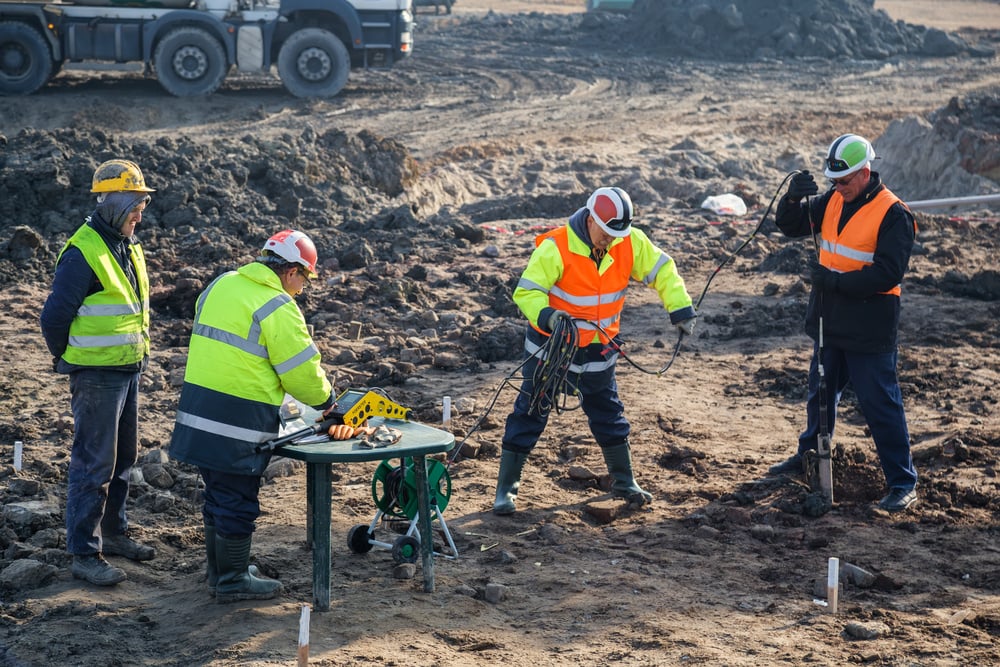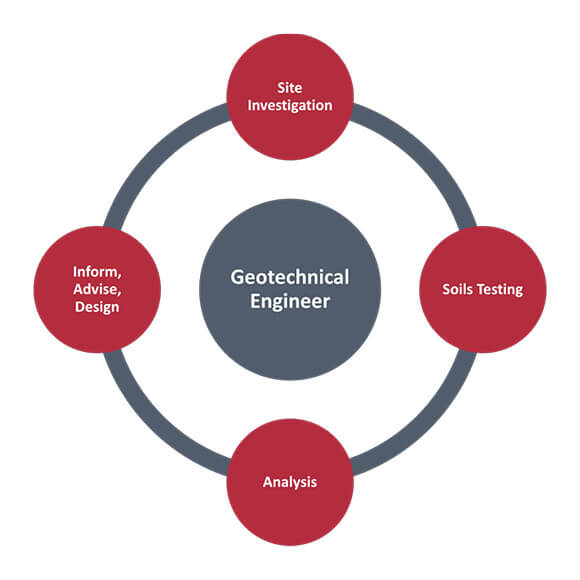Geotechnical Engineering For Construction Projects - An Overview
Wiki Article
Some Known Facts About Geotechnical Engineering For Construction Projects.
Table of ContentsGeotechnical Engineering For Construction Projects Fundamentals ExplainedThe Only Guide for Geotechnical Engineering For Construction ProjectsNot known Incorrect Statements About Geotechnical Engineering For Construction Projects Geotechnical Engineering For Construction Projects Things To Know Before You Get ThisGeotechnical Engineering For Construction Projects Fundamentals ExplainedFacts About Geotechnical Engineering For Construction Projects RevealedThe Of Geotechnical Engineering For Construction Projects
and Kovacs, W. (1981 ), An Introduction to Geotechnical Engineering, Prentice-Hall, Inc. Deep Check Technology (2023 ): Deep Scan Technology uncovers hidden frameworks at the site of Denmark's tallest structure. "Geofrost Coring". GEOFROST. Retrieved 20 November 2020. Han, Jie (2015 ). Concepts and Practice of Ground Enhancement. Wiley. ISBN 9781118421307. RAJU, V. R.Ground Renovation Technologies and Case Histories. Singapore: Research Publishing Providers. p. 809. ISBN978-981-08-3124-0. Ground Improvement Principles And Applications In Asia. Pariseau, William G. (2011 ). Layout analysis in rock auto mechanics. CRC Press. Hegde, A.M. and Palsule P (Geotechnical Engineering for Construction Projects).S. (2020 ), Efficiency of Geosynthetics Reinforced Subgrade Subjected to Repeated Automobile Plenties: Experimental and Numerical Research Studies.
Cengage Knowing, Stamford, 666 p. Atkinson, J., 2007. The auto mechanics of dirts and structures. Taylor & Francis, N.Y., 442 p. Floating Offshore Wind Wind Turbines: Feedbacks in a Sea state Pareto Optimal Designs and Financial Analysis, P. Sclavounos et al., October 2007. Nicholson, D, Tse, C and Dime, C. (1999 ). The Observational Method in ground engineering principles and applications.
Facts About Geotechnical Engineering For Construction Projects Revealed
Lab and field testing plays a vital role in this procedure. By drawing out samples from the planet's subsurface and applying a suite of examinations, geotechnical engineers can predict the practices of dirt layers and assess their viability for numerous building and construction endeavours. The significance of geotechnical engineering in civil engineering can not be overemphasized, attributable to a number of factors: The preliminary action in any geotechnical research involves figuring out the soil type at the building website.
Recognizing these attributes ensures that just suitable dirt kinds are chosen for the growth, consequently avoiding prospective architectural failings. The foundation functions as the bedrock of any type of building task. Selecting the ideal foundation type is a choice that pivots on the thorough analysis supplied by geotechnical design. This ensures the long life and security of structures by fitting the tons they will certainly bear.

Geotechnical website investigation is a critical step in the planning and execution of any type of building and construction task. It involves the collection and analysis of data associated to the physical residential or commercial properties of soil and rock below a suggested construction site. This information is important for the design and building of safe, stable, and lasting frameworks.
A Biased View of Geotechnical Engineering For Construction Projects
In this blog, we will certainly explore the significance of geotechnical site examination, its different components, and just how it benefits construction tasks. Geotechnical website examination, likewise known as subsurface expedition, includes a collection of activities aimed at determining the dirt, rock, and groundwater conditions at a building and construction site. The key goals are to recognize prospective geotechnical hazards, analyze the engineering residential properties of subsurface materials, and supply recommendations for the style and construction of structures, retaining wall surfaces, and various other frameworks.This might include geological maps, aerial pictures, previous examination records, and historical information. The workdesk study assists in recognizing potential More Bonuses geotechnical issues and preparing the succeeding fieldwork. Adhering to the workdesk research, a site reconnaissance is performed to aesthetically evaluate the website and its surroundings. This includes observing the topography, water drainage patterns, existing structures, greenery, and any type of indicators of instability or disintegration.
Geotechnical Engineering For Construction Projects Fundamentals Explained
Superficial test pits are excavated to directly observe and example the dirt and rock. This method works for studying the upper layers of the subsurface and recognizing near-surface dangers. Non-invasive geophysical techniques, such as seismic refraction, ground-penetrating radar (GPR), and electric resistivity tomography (ERT), are utilized to map subsurface conditions and discover abnormalities.Dirt and rock examples collected during the area examination are subjected to laboratory testing to establish their physical and mechanical residential properties. These tests provide necessary information for geotechnical analysis and style.
The key advantage have a peek at this website of geotechnical website investigation is making sure the safety and security and stability of frameworks. By comprehending the subsurface problems, designers can design foundations and various other architectural elements that can endure the tons and ecological forces they will go through. This lessens the threat of settlement, decrease, and architectural failing.
A Biased View of Geotechnical Engineering For Construction Projects
This ensures efficient and secure building and construction practices. Geotechnical website investigations are typically required by constructing codes and policies.This details is indispensable for project supervisors, architects, and service providers in establishing practical routines, budgets, and backup strategies. Geotechnical Engineering for Construction Projects. High-Rise Structure in a Coastal AreaIn a coastal city, a skyscraper residential building was intended on a site with presumed loosened sand deposits and a high water table. An in-depth geotechnical examination, including borehole exploration, CPT, and geophysical surveys, was carried out
Geotechnical Engineering For Construction Projects Can Be Fun For Anyone
Based upon these searchings for, the foundation design was modified to consist of deep heap foundations prolonging into steady strata, and ground enhancement methods, such as vibro-compaction, were applied to mitigate liquefaction risks. This aggressive strategy made certain the safety and stability of the structure while staying clear of expensive post-construction remediation. Facilities Advancement on a Sloping TerrainA major infrastructure project, entailing the construction of a freeway and bridges, was intended on a sloping terrain this contact form with steep slopes.
The Leaning Tower of Pisa (Italy), a legendary building marvel, is infamous for its unintended tilt from significant geotechnical issues. The tower's structure was improperly developed to handle the soft, unpredictable dirt under it, causing unequal settlement and its unique lean. Our globe is dotted with impressive framework projectsfrom towering high-rises to stretching bridgesall standing statement to the evolution of the numerous building and construction equipment and methods readily available.
Geotechnical engineering is a specialized area within civil engineering that focuses on researching the habits of planet materials. This branch delves deep right into the groundinvestigating exactly how the soil, rock, and groundwater at a building site can influenceand be affected bythe facilities that we put up on and into them. Prior to a solitary brick is laid or a concrete structure poured, geotechnical designers probe into the earthgathering essential data about the site's dirt composition, rock framework, and groundwater levels.
Geotechnical Engineering For Construction Projects Fundamentals Explained

is a device made use of to evaluate the stability and load-bearing capability of heaps during installation, leveraging the principle of wave breeding. It optimizes building and construction efficiency by supplying real-time evaluations, thus making sure safe and effective stack structures. Among the sensible applications of geotechnical engineering includes making a decision and executing the best techniques for structure building.
Pile driving represents greater than the plain act of placing structural components right into the ground. On the other hand, it is a meticulously coordinated process of transferring a structure's load past the less secure dirt layers more detailed to the surfacedown to the more substantial strata that lie underneath. In the instance of heap driving, consider how geotechnical engineers expertly use this technique to evenly disperse the framework's weight.
Report this wiki page